-
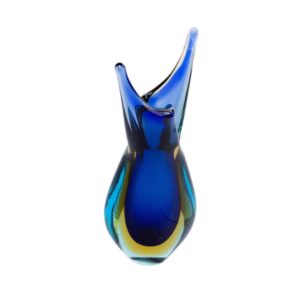
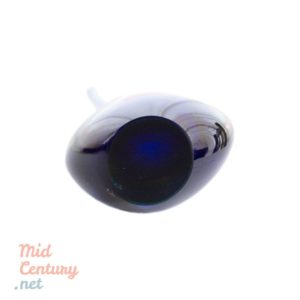
Murano sommerso vase in blue and yellow
Glass & Ceramics, Home AccessoriesBeautiful Murano sommerso vase in blue and yellow. The piece is made in the 1960s and is kept in very good condition, showing no visible deterioration. When thinking of Murano glass, it is highly unlikely that we think of sand, yet this rare material is at the base of all glass production. Glass is firstly a mix of siliceous sand, soda, lime and potassium, which is put to melt inside an oven at a temperature of around 1.500 Celsius. After it has become flexible enough, it is removed with a pipe that will be used to blow the glass out while the glassmaker shapes and models it. The forms and colors given to each piece depend on the tools and chemicals used during its production. The techniques are also important.. One of the most common techniques is “Sommerso”, which in Italian literally means “submerged”. This technique is used to create several layers of glass (usually with different contrasting colors) inside a single object, giving the illusion of “immersed” colors that lay on top of each other without mixing. This is done by uniting different layers of glass through heat and repeatedly immersing them in pots of molten colored glass. This technique is quite recognizable: it is characterized by an outer layer of colorless glass and thick layers of colored glass inside it, as if a big drop of color had been captured inside the transparent glass. When one first sees these objects, it seems almost impossible to conceive such beautiful colors being locked so perfectly inside what would seem solid glass, and then undoubtedly one begins to wonder how ever did they manage to achieve such a complex game of shapes and colors right in the middle of a clear glass object. Source: glassofvenice.com55 €55 € -


Small purple Murano bowl made in the 1970s
Glass & Ceramics, Home AccessoriesSmall purple Murano bowl made in the 1970s. Nicely colored in an exquisite purple shade, the bowl features a "half an apple" shape, which has been very popular in Murano since the second half of the 1950s. The bowl is in very good vintage condition. During World War II the industry did not thrive, but as soon as the war was over the glass masters of Murano returned to their art and created pieces deeply rooted in interior design trends of that time with focus on minimalism, functionality, and simplicity. To support these trends Murano artists and artisans returned to techniques of the past such as filigree, murrino, and lattimo. From that point onwards Murano saw continued exploration of styles and techniques striving to find a happy medium between the technical mastery and the outline, color, and decoration. The resulting continuous innovation led to a rise in popularity and to multiple prizes at various international art exhibitions. Thanks to such prominent artists as Archimede Seguso, Ludovico and Laura De Santillana, Tobia Scarpa, Ercole Barovier, Fulvio Bianconi, Toni Zuccheri, Romano Chrivi, Giampaolo Martinuzzi, and Alfredo Barbini, Murano again became known as the glassblowing capital of the world. Murano now created the art trends as opposed to following them in the years past. Source: glassofvenice.com30 €30 € -

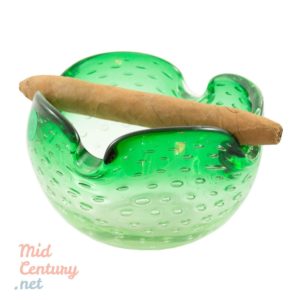
Controlled bubbles (bullicante) Murano ashtray
Glass & Ceramics, Home AccessoriesBeautiful controlled bubbles (bullicante) Murano ashtray made of glass. Hand blown, this piece displays a nice chromatic effect and goes from dark green (to the rim) to clear white (at the bottom). The quality and tradition that characterize Murano’s finest glass furnaces have always been worthy of the highest appreciation. This prestige is due mostly to the glass masters’ hard work and dedication, which are the very core of Murano’s most famous trade. Glassmaking has been passed on from one generation to the next one, with constant innovations and timeless originality. The loyalty and respect with which this trade is treated is possibly the key to Murano’s success. Glass masters all over the island have always worked with endless vitality, and this creative vein is evident in every glass artwork that comes out of any furnace, with improved techniques and bewildering effects. The “bullicante” effect is amongst the most famous glass making techniques and it is seen quite often around the island of Murano. If you’ve had the fortune of strolling along the streets of Venice, you would have noticed beautiful glass pieces with small air bubbles trapped in the inside, possibly stopping to wonder how that seemingly impossible effect is achieved. This peculiar effect is obtained by placing a piece of molten glass inside a metallic mold with spikes, very much resembling a pineapple’s texture. These spikes cause small holes on the surface creating a pattern all around the glass piece. After it’s been left to cool down for a few moments, the whole piece is submerged in molten glass again. This second layer completely covers the first one. However, thanks to the thick consistency of glass, the holes previously impressed on the first layer are not covered, thus causing air to be trapped between both layers of glass. This process can be repeated several times, creating a pattern as complicated as the glass master wishes. This technique gives not only a sense of depth to the whole object, but also an incomparable decorative effect, famous for its originality. Source: glassofvenice.com40 €40 € -
Sold out


Spectacular Murano cigar ashtray from the 1960s
Sold ItemsSpectacular Murano cigar ashtray made of glass. The piece is distinguished by its fluid shapes, by the fine quality of the glass, as well as by its intense and extremely beautiful ruby red color. Hand blown, this piece is kept in very good vintage condition. The quality and tradition that characterize Murano’s finest glass furnaces have always been worthy of the highest appreciation. This prestige is due mostly to the glass masters’ hard work and dedication, which are the very core of Murano’s most famous trade. Glassmaking has been passed on from one generation to the next one, with constant innovations and timeless originality. The loyalty and respect with which this trade is treated is possibly the key to Murano’s success. Glass masters all over the island have always worked with endless vitality, and this creative vein is evident in every glass artwork that comes out of any furnace, with improved techniques and bewildering effects. Source: glassofvenice.com45 €45 € -
Sold out
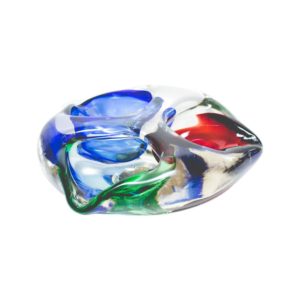

Tricolor Murano ashtray (or dish) in blue, red and green
Sold ItemsTricolor Murano ashtray (or dish) in blue, red and green. This piece is remarkable in its fluid shapes, the zoomorphic look (seen from the top, it resembles the image of a cat's head), the fine quality of the glass, and the dialogue between the three differently colored compartments. Hand blown, this piece is kept in very good vintage condition. The quality and tradition that characterize Murano’s finest glass furnaces have always been worthy of the highest appreciation. This prestige is due mostly to the glass masters’ hard work and dedication, which are the very core of Murano’s most famous trade. Glassmaking has been passed on from one generation to the next one, with constant innovations and timeless originality. The loyalty and respect with which this trade is treated is possibly the key to Murano’s success. Glass masters all over the island have always worked with endless vitality, and this creative vein is evident in every glass artwork that comes out of any furnace, with improved techniques and bewildering effects. Source: glassofvenice.com45 €45 € -
Sold out
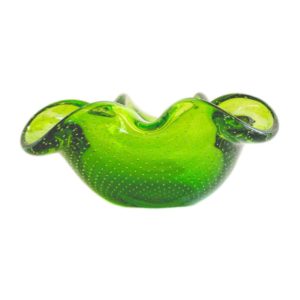

Green bullicante Murano ashtray
Sold ItemsBeautiful controlled bubbles (bullicante) ashtray made of glass in Murano, Italy, in the 1960s. Hand blown, this pice features the shape of a flower in an amazing shade of translucent emerald green. The quality and tradition that characterize Murano’s finest glass furnaces have always been worthy of the highest appreciation. This prestige is due mostly to the glass masters’ hard work and dedication, which are the very core of Murano’s most famous trade. Glassmaking has been passed on from one generation to the next one, with constant innovations and timeless originality. The loyalty and respect with which this trade is treated is possibly the key to Murano’s success. Glass masters all over the island have always worked with endless vitality, and this creative vein is evident in every glass artwork that comes out of any furnace, with improved techniques and bewildering effects. The “bullicante” effect is amongst the most famous glass making techniques and it is seen quite often around the island of Murano. If you’ve had the fortune of strolling along the streets of Venice, you would have noticed beautiful glass pieces with small air bubbles trapped in the inside, possibly stopping to wonder how that seemingly impossible effect is achieved. This peculiar effect is obtained by placing a piece of molten glass inside a metallic mold with spikes, very much resembling a pineapple’s texture. These spikes cause small holes on the surface creating a pattern all around the glass piece. After it’s been left to cool down for a few moments, the whole piece is submerged in molten glass again. This second layer completely covers the first one. However, thanks to the thick consistency of glass, the holes previously impressed on the first layer are not covered, thus causing air to be trapped between both layers of glass. This process can be repeated several times, creating a pattern as complicated as the glass master wishes. This technique gives not only a sense of depth to the whole object, but also an incomparable decorative effect, famous for its originality. Source: glassofvenice.com55 €55 € -
Sold out
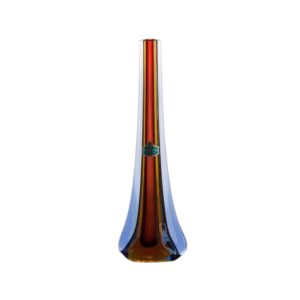

“Teardrop” Murano sommerso vase from the 1960s
Sold ItemsSpectacular Murano sommerso vase for one flower (soliflore) in shades of red (the interior layer), yellow (the median layer) and blue (the outer layer). Because of its shape, this type of vase is also known as "Teardrop". The piece is made in the 1960s and is kept in very good condition, showing no visible deterioration. It has its original label. When thinking of Murano glass, it is highly unlikely that we think of sand, yet this rare material is at the base of all glass production. Glass is firstly a mix of siliceous sand, soda, lime and potassium, which is put to melt inside an oven at a temperature of around 1.500 Celsius. After it has become flexible enough, it is removed with a pipe that will be used to blow the glass out while the glassmaker shapes and models it. The forms and colors given to each piece depend on the tools and chemicals used during its production. The techniques are also important.. One of the most common techniques is “Sommerso”, which in Italian literally means “submerged”. This technique is used to create several layers of glass (usually with different contrasting colors) inside a single object, giving the illusion of “immersed” colors that lay on top of each other without mixing. This is done by uniting different layers of glass through heat and repeatedly immersing them in pots of molten colored glass. This technique is quite recognizable: it is characterized by an outer layer of colorless glass and thick layers of colored glass inside it, as if a big drop of color had been captured inside the transparent glass. When one first sees these objects, it seems almost impossible to conceive such beautiful colors being locked so perfectly inside what would seem solid glass, and then undoubtedly one begins to wonder how ever did they manage to achieve such a complex game of shapes and colors right in the middle of a clear glass object. Source: glassofvenice.com100 €100 € -
Sold out


Murano sommerso vase from the 1950s
Sold ItemsBeautiful Murano sommerso vase in green and purple. The piece is made in the 1950s and is kept in very good condition, showing no visible deterioration. It has the original label. When thinking of Murano glass, it is highly unlikely that we think of sand, yet this rare material is at the base of all glass production. Glass is firstly a mix of siliceous sand, soda, lime and potassium, which is put to melt inside an oven at a temperature of around 1.500 Celsius. After it has become flexible enough, it is removed with a pipe that will be used to blow the glass out while the glassmaker shapes and models it. The forms and colors given to each piece depend on the tools and chemicals used during its production. The techniques are also important.. One of the most common techniques is “Sommerso”, which in Italian literally means “submerged”. This technique is used to create several layers of glass (usually with different contrasting colors) inside a single object, giving the illusion of “immersed” colors that lay on top of each other without mixing. This is done by uniting different layers of glass through heat and repeatedly immersing them in pots of molten colored glass. This technique is quite recognizable: it is characterized by an outer layer of colorless glass and thick layers of colored glass inside it, as if a big drop of color had been captured inside the transparent glass. When one first sees these objects, it seems almost impossible to conceive such beautiful colors being locked so perfectly inside what would seem solid glass, and then undoubtedly one begins to wonder how ever did they manage to achieve such a complex game of shapes and colors right in the middle of a clear glass object. Source: glassofvenice.com75 €75 € -
Sold out
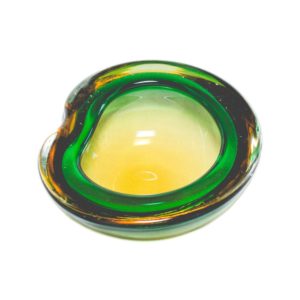

Green and brown bowl made in Murano, in the 1950s
Sold ItemsBeautiful geode bowl made in Murano, Italy, in the 1950s. Nicely colored, in shades of brown and green, this is a hand blown piece kept in very good vintage condition. Murano glass Geode bowls earn the name "geodes" due to their resemblance to geode rocks - rocks or stones that have been sliced neatly in two. The geode bowls therefore have a perfectly flat, wide rim. Murano glass geodes consist of two or more layers of cased glass. They were made my several Italian glass manufacturers from the Venetian island of Murano, and as such it is virtually impossible to identify the maker of an unmarked bowl. Popular geode shapes include circular, square, triangular, figure eight, and kidney shaped among others. Source: 20thcenturyglass.com50 €50 € -
Sold out


Imposing emerald fruit bowl made in Murano in the 1970s
Sold ItemsImposing emerald fruit bowl made in Murano in the 1970s. This tall, massive, beautifully colored piece is in very good vintage condition, showing no visible defects. During World War II the industry did not thrive, but as soon as the war was over the glass masters of Murano returned to their art and created pieces deeply rooted in interior design trends of that time with focus on minimalism, functionality, and simplicity. To support these trends Murano artists and artisans returned to techniques of the past such as filigree, murrino, and lattimo. From that point onwards Murano saw continued exploration of styles and techniques striving to find a happy medium between the technical mastery and the outline, color, and decoration. The resulting continuous innovation led to a rise in popularity and to multiple prizes at various international art exhibitions. Thanks to such prominent artists as Archimede Seguso, Ludovico and Laura De Santillana, Tobia Scarpa, Ercole Barovier, Fulvio Bianconi, Toni Zuccheri, Romano Chrivi, Giampaolo Martinuzzi, and Alfredo Barbini, Murano again became known as the glassblowing capital of the world. Murano now created the art trends as opposed to following them in the years past. Source: glassofvenice.com100 €100 € -
Sold out

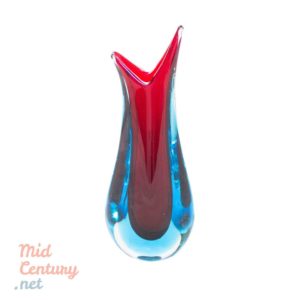
Beautiful Murano sommerso vase
Sold ItemsBeautiful Murano sommerso vase in red and blue. The piece is made in the 1960s and is kept in very good condition, showing no visible deterioration. When thinking of Murano glass, it is highly unlikely that we think of sand, yet this rare material is at the base of all glass production. Glass is firstly a mix of siliceous sand, soda, lime and potassium, which is put to melt inside an oven at a temperature of around 1.500 Celsius. After it has become flexible enough, it is removed with a pipe that will be used to blow the glass out while the glassmaker shapes and models it. The forms and colors given to each piece depend on the tools and chemicals used during its production. The techniques are also important.. One of the most common techniques is “Sommerso”, which in Italian literally means “submerged”. This technique is used to create several layers of glass (usually with different contrasting colors) inside a single object, giving the illusion of “immersed” colors that lay on top of each other without mixing. This is done by uniting different layers of glass through heat and repeatedly immersing them in pots of molten colored glass. This technique is quite recognizable: it is characterized by an outer layer of colorless glass and thick layers of colored glass inside it, as if a big drop of color had been captured inside the transparent glass. When one first sees these objects, it seems almost impossible to conceive such beautiful colors being locked so perfectly inside what would seem solid glass, and then undoubtedly one begins to wonder how ever did they manage to achieve such a complex game of shapes and colors right in the middle of a clear glass object. Source: glassofvenice.com110 €110 € -
Sold out
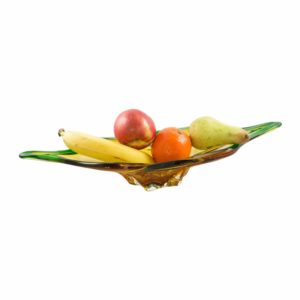
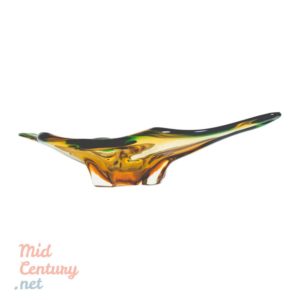
Green & brown Murano fruit bowl made in the 1950s
Sold ItemsGreen & brown Murano fruit bowl made in the 1950s. Of considerable size and, at the same time, remarked by the suppleness of its lines and silhouette, this fruit bowl (kept in very good vintage condition) can successfully be the central piece of any table. During World War II the industry did not thrive, but as soon as the war was over the glass masters of Murano returned to their art and created pieces deeply rooted in interior design trends of that time with focus on minimalism, functionality, and simplicity. To support these trends Murano artists and artisans returned to techniques of the past such as filigree, murrino, and lattimo. From that point onwards Murano saw continued exploration of styles and techniques striving to find a happy medium between the technical mastery and the outline, color, and decoration. The resulting continuous innovation led to a rise in popularity and to multiple prizes at various international art exhibitions. Thanks to such prominent artists as Archimede Seguso, Ludovico and Laura De Santillana, Tobia Scarpa, Ercole Barovier, Fulvio Bianconi, Toni Zuccheri, Romano Chrivi, Giampaolo Martinuzzi, and Alfredo Barbini, Murano again became known as the glassblowing capital of the world. Murano now created the art trends as opposed to following them in the years past. Source: glassofvenice.com110 €110 € -
Sold out


Murano orange fruit bowl
Sold ItemsImpressive fruit bowl made in Murano in the second half of the 1950s. The piece distinguishes itself through the transparency of the orange pigment, which goes up to red at certain times of the day when light is favorable. The irregular shape - of natural inspiration - radiates from the center. A rare piece, kept in excellent condition.110 €110 €
Murano
Home » Murano
